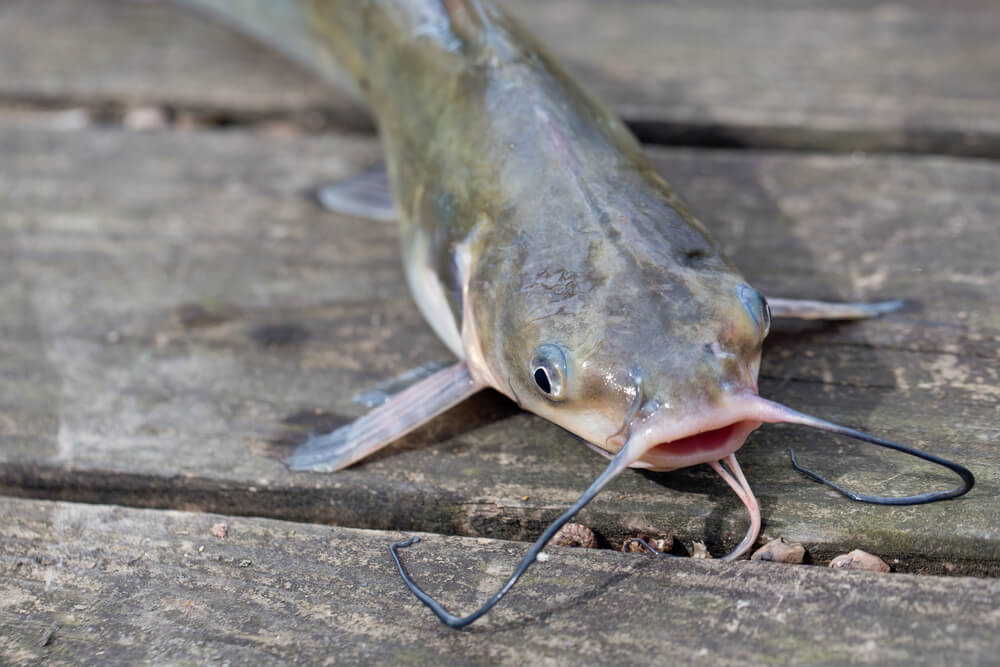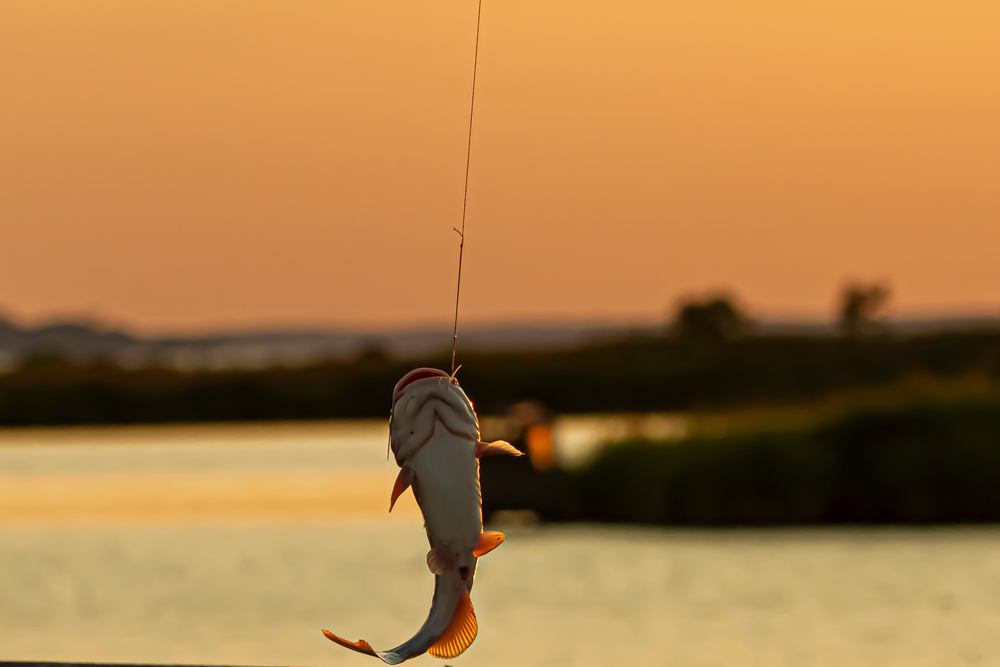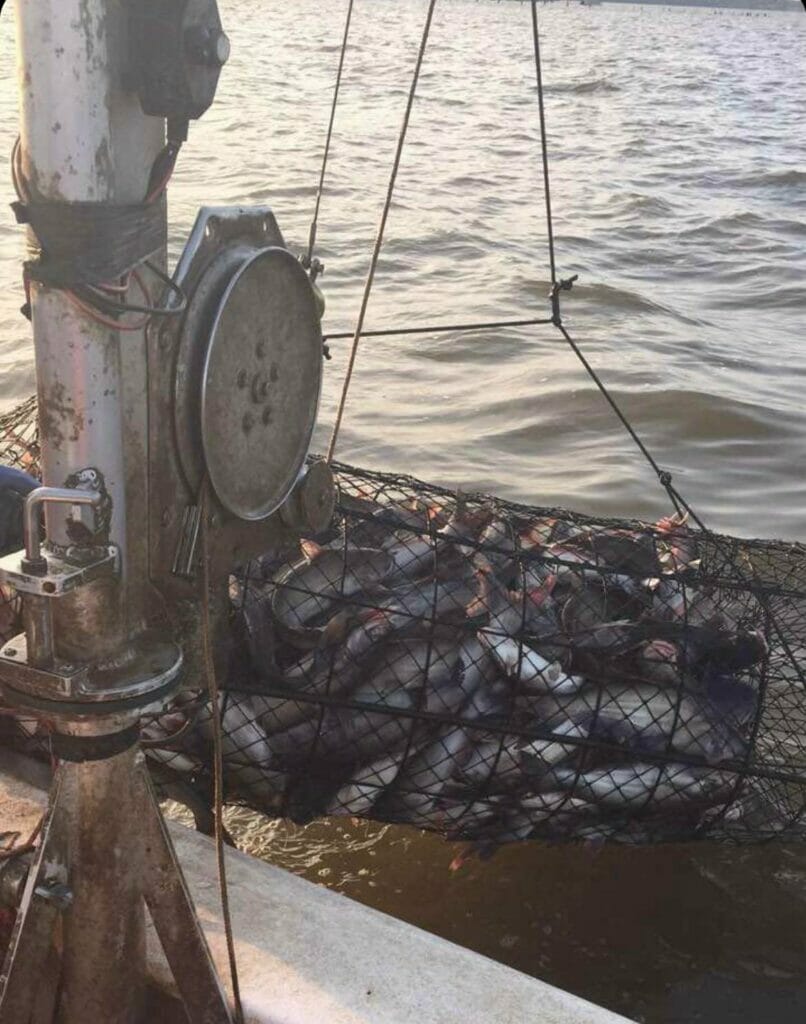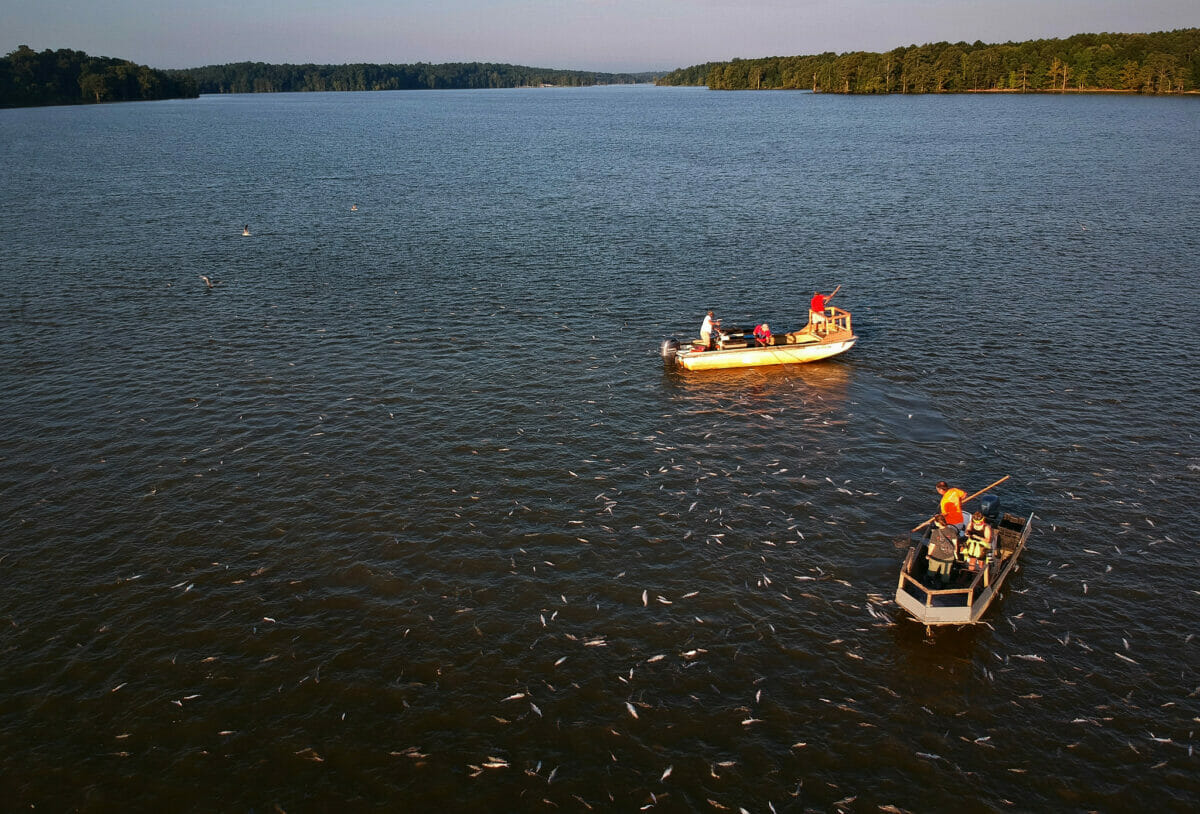A controversial USDA inspection rule has had unintended consequences for the farm-raised and wild-caught catfish industries—as well as the food system they’re meant to support.

I grew up swimming in the muddy Rappahannock River in Virginia where the catfish are so plentiful, sometimes they’d bump right into me, scaring both of us. We could catch dinner in our backyard, which made a difference to us as low-income farmers. Even today, I can reel in a dozen blue catfish in less than an hour, more than enough to feed a family. Those golden fried fillets of white, flaky meat dipped in cornmeal and flour with a sprinkle of Old Bay, and the catfish chowder my mother makes from scratch, taste better than any fish I know.
Virginia introduced the blue catfish for recreational fishing in the 1970s, but now there’s no putting the cat back in the bag. With high reproductive rates and few predators, the blue catfish makes up approximately 70 percent of the fish biomass—more than 100 million wild catfish—in the Chesapeake Bay and its tributaries. That’s a lot of dinners.
It’s no wonder that so many Chesapeake fisherfolk have relied on the abundant catfish for an income. And as blue catfish numbers increase, to the detriment of other species it gobbles up such as the blue crab, it’s important as ever to keep on fishing.

Blue catfish are commonly caught in Virginia and Maryland, where they’re abundant in the Chesapeake Bay watershed area. Photo by grandbrothers, Shutterstock.
But since 2016, processing plants from Maryland to Louisiana have stopped taking wild catfish, leaving some fisherfolk with nowhere to turn. Virginia fisherman Aaron Bosse often has had to release 10,000 pounds of catfish back into the water and pull up his gear because “there’s no market,” he says.
Lobbyists such as the Catfish Farmers of America, a group of farm-raised catfish producers in Mississippi, pushed through a provision in the 2008 and 2014 Farm Bills to distinguish farm- or channel-raised catfish from cheaper, imported catfish, which threatened their sales. The provision took away the responsibility of inspecting catfish from the FDA and required on-site USDA inspectors at all catfish processing plants, both wild-caught and farmed.
The cost? According to a USDA spokesperson, in 2018, Congress increased the USDA’s Food Safety and Inspection Service’s annual funding by $5.5 million to cover the expenses of the extra workload. The FDA program had only cost taxpayers $700,000 annually. The USDA inspectors’ high pay rates, upward of $70 an hour, and stringent facility requirements makes processing wild-caught catfish cost prohibitive for processors.
“It was a lot of heartache and a lot of money to upgrade to new standards,” says Ricky Nixon of Murray L. Nixon Fisheries in North Carolina, one of only a few processors left in North Carolina and Virginia who take wild-caught catfish. “Fishermen are raising Cain. They were packing their own catfish, but now they can’t do it because they’re not USDA-approved.”
[RELATED: This Ugly Fish Could Be The Future of Aquaculture]
Maryland overturned the regulation in April 2021, but for years, politicians have pushed against the controversial USDA inspection program to no avail. What’s worse, since 2016—when USDA oversight began—the provision has done little to help the farm-raised catfish market it intended to protect. Foreign imports of catfish, often labeled basa, swai or tra, still have a stronghold on the market. According to US Census, NOAA and USDA data, the average value of domestic and imported farmed catfish sales combined per year over the last 10 years totaled approximately $350 million. Today, imports from Vietnam and China still account for nearly half of all farmed catfish sales in the US, showing continued robust competition and a slight downturn due to the pandemic.
COVID-19 has created unprecedented challenges for the catfish industry. Processing plants saw historic staff shortages; restaurant sales plummeted, which provided more than half of some producers’ incomes; contracts were cancelled; feed prices went up; and holding fish in ponds increased costs. Many catfish farmers held on to fish that are now too big to sell, having outgrown saleable size limits during the pandemic. In 2020, the USDA bought $30 million in domestic farm-raised catfish for food banks, supporting the farm-raised industry; however, it left wild-caught catfish out in the cold.
The price of wild-caught catfish has slowly increased over time. For the consumer, frozen wild-caught fillets can cost $20 per pound or more, while domestic farmed fillets can retail at $6.50 per pound. Even though the Chesapeake blue catfish’s diet of blue crab and smaller fish—a similar diet to the gourmet striped bass—makes for firmer, flakier meat, wild-caught catfish can be a hard sell in the grocery aisle when farmed fish is much cheaper.

Many fisherfolk are forced to release their wild-caught catfish back into the water. Photo courtesy of Aaron Bosse.
Without market incentives for fisherfolk to control the blue catfish’s booming population in the Chesapeake Bay region, since 2020, the Virginia Marine Resource Commission has held an annual lottery for three commercial electrofishing licenses for Virginia rivers. The process of electrofishing is like firing a Taser gun in the water. Two submerged electrodes emit a current that causes uncontrolled muscular convulsions in fish and other wildlife, making them float to the surface and easy to capture. Scientists use electrofishing as a research tool to conduct periodic fish surveys and stock assessments; however, most of the world has banned electrofishing as a commercial fishery—China in 2000, and the EU recently, due to the potential harm to marine ecology and the economic threat to traditional fisheries. And the rise of commercial electrofishing, an unintended result of USDA regulations, has Virginia fisherfolk enraged.
For generations, Virginia fisherfolk families have paid state gear and license fees for a traditional fishery using hoop nets and pound nets to catch blue catfish. Hoop nets and pound nets herd fish into traps where fisherfolk can cull through a live catch, releasing any bycatch back into the river essentially unharmed. Developed by Indigenous cultures of the Chesapeake Bay, this style of passive fishery has been sustainably carried on for centuries.
Wayne Fisher, who has pound-netted catfish on the Rappahannock River for 30 years, sees Virginia’s electrofishing as inequitable and a threat to his future. “I just don’t think it’s right that somebody can come to the river where I’ve been working for decades and shock all these fish 100 yards off my nets,” says Fisher. “Get some pots, get some nets, and go out and work for it like I do. I’d go to jail for owning the same equipment.”

In Virginia, fishermen catch blue catfish through low-frequency electrofishing, a method that delivers a nonlethal stun to catfish. Photo courtesy of Virginia Sea Grant.
Some scientists are concerned about how shocking the water affects fish behavior using the specific electroshocking gear type, which emits low frequencies to target blue catfish. “I’m concerned about potential disruptions to spawning migrations and feeding habits of other fish,” says Bob Greenlee, who worked as the Eastern region fisheries manager at the Virginia Department of Wildlife Resources for 24 years. “Endangered Atlantic sturgeon moving up our rivers to spawn are sensitive to low levels of electrical current. We just don’t know what those impacts might be,” he says.
Hardworking fisherfolk using traditional means can significantly reduce blue catfish populations without unknown consequences to the environment. But only if the effort is made worthwhile by overturning restrictive USDA regulations for the wild-caught market.
Fisherfolk consider catfish a valuable commodity. “These catfish are a big focus of my livelihood, to take care of my family,” Wayne Fisher says. “I’ve caught millions of pounds of them. I know how to catch them. I just need a way to sell them.”
[RELATED: The Future of Ocean Farming]
The Wide Net Project, a nonprofit organization based in Washington, DC, believes we should take advantage of the overabundant resource by both increasing demand for the sustainable wild-caught fishery and providing fillets to hunger relief agencies to address food insecurity.
The communities where catfish thrive often experience high poverty rates. Where I grew up, in Richmond County, Virginia, more than 17 percent of residents live in poverty. Food banks in the Chesapeake Bay area serve tuna, an overfished species, while an untapped resource swims right in their rivers.
That’s why the Wide Net Project works to get the invasive, and nutritious, blue catfish to those in need. “We looked at the parts of the food system that were not connected—food access, hunger relief and the environment—to bring them together,” co-founder Wendy Stuart says. Since 2012, the Wide Net Project has connected with fisherfolk and processors to serve tens of thousands of pounds of blue catfish to community centers, food banks and grocery stores to combat hunger, grow market demand and protect the environment.
But there’s still a lot of catfish left in the Bay, and the pandemic has brought hunger into sharp relief. “We’ve definitely seen an increase in need since the pandemic,” says Elizabeth Gilkey, grants and communications manager of Feeding America, based in Fredericksburg, Virginia. “Now we’re seeing people who are coming to us multiple times. COVID-19 has created a long-term need for food assistance.”
The expensive USDA catfish regulation has wide-reaching consequences—for communities in need, processors and fisherfolk, as well as the environment. Fisherfolk are tired of being held back. Many believe Congress needs to address the full impact of the regulation, to help repair this ineffective food system. Because when food systems work efficiently, everyone benefits.
Bureaucratic sludge and unsupportable expense eliminated frog legs and rabbit as a product of the USA. Feral hogs could be harvested but can’t. Calf testicles (a substantial appetizer in my business) are wasted, driving the price high. Requiring USDA approval at most stages of production is not sustainable. As a restaurant owner it takes effort to not purchase product from China. Why is it cheaper to grow, process, can, ship and distribute canned corn, peaches and water packed apples from China? Common sense is legislated away. We are our own worst enemy. The canned whole kernel corn is dent corn,… Read more »
Good article, important issue! What can we do?
Not sure of your numbers, I suspect they are different in different parts of the country. My dad stopped buying farm raised catfish in Indiana when it hit $18 a lb. I cannot even get it here in Northern Wisconsin in the stores and it is more than Walleye in the restaurants. I also see a similarity in what Indiana did to their commercial fishermen when they made it impossible for them to sell their fish direct without expensive upgrades. Now they have no one to stop Asian Carp.
Wild catfish down South/bullhead in Ct. is the best,farm raised tastes likr mud.
I just looked at a report about Chinas fish they have bad pouted water, with heavy metals in them . With many time more pollutants that will make you sick. 80% of all fish from China were found to be way over the toxic levels! Fact is we should not eat any fish from China, Vietnam and most other country’s in that part of the world for they can even kill you with to much toxins Check it out on U Tube for your self.
This article provides a good overview of the issues caused by the USDA Law. It is a shame the law was initiated by the US catfish-farm community and later passed by the Government. Most people agree that the intended results of the law have fallen short of expectations and modifications or removal would be best. However, there are several issues about some comments that should be addressed regarding the low-frequency electrofishing and commercial fishing in the region. Warning, this is a long paragraph that takes a journey deep into the rabbit hole. Written quickly so please forgive grammatical errors. First… Read more »
I was forced to close my catfish farm in Puerto Rico due to this regulation. It would be of great benefit to me and other small scale fish farmers if they would repeal this act. It has done a lot more harm than good.
Maybe some of these people or companies could donate the fish and write it off on their taxes as either a donation or a business loss…
How long r u going to make these entries? You read for days. Great information – just condense the writing, and give possible solutions.